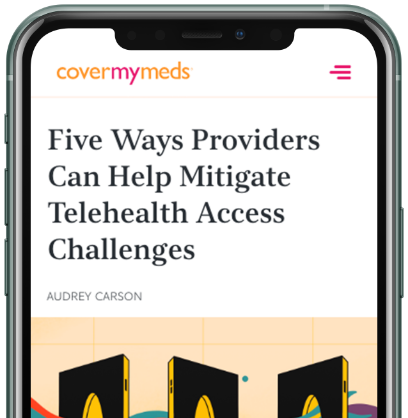Specialty Medications: Hope for Patients, Hurdle for Healthcare
In part three of our History of Healthcare IT series, we explore the origins and industry response to specialty medications. Few developments in healthcare have drastically impacted stakeholders quite like the emergence and wide-spread utilization of these high-cost, high-complexity drugs.

Beyond potential life-changing clinical benefits for patients, specialty medications have profound implications for providers, payers, pharmacies and the life sciences brands who create these therapies.
In the last in our three-part series on healthcare IT — catch up with part one and part two — we explore the challenges associated with specialty medications and the need for electronic innovation to improve a process that’s difficult for all stakeholders.
Specialty drugs have become the fastest-growing, largest segment of the total pharmacy market in the U.S. While representing only 2.2 percent of U.S. prescription volume, these therapies accounted for 36 percent of pharmacy industry revenue in 2019 — about $161 billion.Medication Use and Spending in the U.S., A Review of 2018 and Outlook to 2023, IQVIA, 2019,The State of Specialty Pharmacy 2020: Market Data and Trends, Drug Channels, 2020
Year-over-year growth in specialty drug revenue — as well as new drug applications for specialty therapeutics at the U.S. Food & Drug Administration (FDA) — underline the persistent industry trend toward specialty.New Drug Therapy Approvals 2020, U.S. Food & Drug Administration, 2020
*The number of specialty medications on the market has increased more than 1,200 percent since the mid-1990s.What Lies Ahead for Pharmacists in 2021, Pharmacy Times, 2021 *
While specialty medications were once low volume — often limited to small patient populations for rare diseases like hemophilia, human immunodeficiency virus (HIV), multiple sclerosis (MS) and Gaucher’s diseaseThe Evolution of Specialty Pharmacy, Biotechnology Healthcare, 2008 — continued research into rare and complex diseases has resulted in more therapies reaching the market.FAQs About Rare Diseases, Genetic and Rare Diseases Information Center, 2021
Rare diseases — those affecting less than 200,00 people — collectively affect 25 to 30 million Americans, while nearly 2 million Americans are diagnosed with cancer each year.FAQs About Rare Diseases, Genetic and Rare Diseases Information Center, 2021, Cancer Statistics, National Cancer Institute, 2020
Many of these patients are presented with limited treatment options. However, by 2023, it’s projected that 65 percent of new drug launches will be specialty therapies, many indicated for rare diseases and cancer.The Global Use of Medicine in 2019 and Outlook to 2023, IQVIA Institute, 2019
Features of Specialty Medications
Specialty therapies possess a few characteristics that set them apart from traditional retail medications. Knowing these differences is important for understanding why patients can struggle with access.
- Scientific Complexity: Specialty therapies can go beyond managing symptoms to treating the underlying causes of disease. They often have targeted mechanisms of action and may be large macromolecules, termed biologics. Cell and gene therapies are also emerging as effective new treatment options for those with cancer and rare disease.The Key to Commercializing Revolutionary Gene Therapies and Other Orphan Drugs: High-Touch Services that Enhance Patient Outcomes, McKesson, 2018
- Safety Considerations: Specialty therapies can be granted priority status by the FDA, which allows for accelerated review processes. However, clinical trial enrollment for these therapies can be constrained by relatively small patient populations.Fast Track, Breakthrough Therapy, Accelerated Approval, Priority Review, U.S. Food & Drug Administration, 2018
- Route of Medication Administration: Many specialty therapies aren’t amenable to pill form for simple oral administration — as a result, patients may take medication via nebulization, injection or infusion.
- Cost: Consider this: In 2017, the average annual retail cost of a specialty medication was $78,781 — nearly $10,000 more than the median household income.Trends in Retail Prices of Specialty Prescription Drugs Widely Used by Older Americans: 2017 Year-End Update, American Association of Retired Persons, 2019, Income and Poverty in the United States: 2019, United States Census Bureau, 2020
Understanding Complex Therapies
Approved specialty medications and those in development can be complex — often far different than traditional small organic molecules. Many are classified as biopharmaceuticals — or “biologics” — and can demand novel methods for large-scale manufacturing, as well as strict storage and handling instructions. An example of this is cold-chain distribution, wherein the product is strictly temperature controlled from the time it is manufactured to immediately before administration.The Key to Commercializing Revolutionary Gene Therapies and Other Orphan Drugs: High-Touch Services that Enhance Patient Outcomes, McKesson, 2018
For some immunotherapies, like chimeric-antigen receptor T-cells (CAR-T), a cancer patient’s immune cells are removed from their body and sent to a lab for genetic-modification to specifically recognize the cancer, before being reinfused back into the patient. Such complicated science is accompanied with complicated logistics in terms of patient eligibility, provider education and therapy distribution.The Key to Commercializing Revolutionary Gene Therapies and Other Orphan Drugs: High-Touch Services that Enhance Patient Outcomes, McKesson, 2018
New Patient Insights
The COVID-19 pandemic was especially hard on patients prescribed specialty therapies.
For the first five months of 2020, use of key autoimmune, oncology and osteoporosis drugs fell by as much as 53 percent below 2019 levels.Monitoring the Impact of COVID-19 on the Pharmaceutical Market, IQVIA Institute, 2020 This drop can be attributed to patients distancing from medical facilities where providers administer infusion and injectable drugs.Specialty Pharmacy Keeps Disrupting Buy-and-Bill—and COVID-19 Will Accelerate It, Drug Channels, 2020 Nearly half of providers CoverMyMeds surveyed reported that they changed how they approach specialty patient appointments due to COVID-19; nearly one in five providers saw a decrease in patient therapy compliance.Provider Survey, CoverMyMeds, 2020
And then there’s the cost of these medications. Patients reported they’re more likely to abandon specialty therapies than any other drugs during their deductible period, when they’re responsible for paying for the bulk of their healthcare.Health Insurance Coverage: Early Release of Estimates From the National Health Interview Survey, January–September 2018, National Center for Health Statistics, 2019
But while the high cost of specialty medications is a major barrier, simply accessing therapy can prove just as — if not more — difficult. Once receiving a diagnosis and prescription for a complex therapy, many patients are often left to manage their own care. Of the patients CoverMyMeds surveyed, 82 percent reported spending an hour on the phone coordinating care for specialty therapies. More than a third spent at least three hours.Patient Survey, CoverMyMeds, 2020
The Evolution of Hub Services
Specialty medications can require unique administration (nebulizer, injections, infusions), consistent patient monitoring through lab tests or regular checkups and time-intensive up-front processes, including enrollment documentation, benefit verification safety and educational components, prior authorization (PA), as well as risk evaluation and mitigation strategies (REMS).
Unfortunately, communication and coordination of efforts among the various healthcare stakeholders to fulfill these steps in a timely and efficient manner is difficult — and can lead to delays in therapy for patients. Stark differences in distribution, enrollment and reimbursement processes for specialty medications relative to traditional drugs present unique challenges to each healthcare stakeholder.
Specialty pharmacies and specialty hubs have evolved to help navigate and mitigate the challenges impeding patient access. While these services attempt to help patients and providers, the overall process is still often considered inefficient and burdensome — with manual fulfillment of steps the current standard.
Enter specialty dashboards and tech-enabled hub services, which can electronically enroll patients during an appointment to begin therapy sooner while also reducing administrative work for provider offices. Patients can then electronically navigate affordability, benefit verification, pharmacy access and medication mode of delivery. In some cases, such inclusive patient support services have contributed to a 34 percent reduction in time to therapy.Data on File, CoverMyMeds, 2020
Through continued development of electronic patient support services, available at the point of prescribing for prescribers and their staff, more patients can experience end-to-end support to access specialty medications.
For more about technology’s impact on specialty medication access, read the 2021 Medication Access Report.
The latest healthcare insights, floated right to your inbox.



